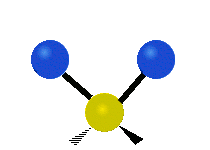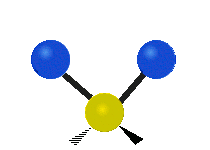Vibrational circular dichroism


 File:Twisting.gif Vibrational Circular Dichroism (VCD) is an analytical technique that measures the difference in absorption of left-handed and right-handed circularly polarized light by chiral molecules. It is a subset of circular dichroism that specifically pertains to vibrational transitions, as opposed to electronic transitions. VCD provides detailed information about the three-dimensional structure of molecules in solution, making it a valuable tool in the fields of chemistry, biochemistry, and molecular biology.
File:Twisting.gif Vibrational Circular Dichroism (VCD) is an analytical technique that measures the difference in absorption of left-handed and right-handed circularly polarized light by chiral molecules. It is a subset of circular dichroism that specifically pertains to vibrational transitions, as opposed to electronic transitions. VCD provides detailed information about the three-dimensional structure of molecules in solution, making it a valuable tool in the fields of chemistry, biochemistry, and molecular biology.
Overview[edit | edit source]
VCD is based on the phenomenon that chiral molecules will absorb left and right circularly polarized light to different extents. This difference in absorption can be measured and used to deduce information about the molecular structure of the compound. VCD is particularly sensitive to the stereochemistry of molecules, including their conformation and absolute configuration. It complements other spectroscopic methods like Nuclear Magnetic Resonance (NMR) and X-ray crystallography, offering unique insights, especially for molecules in solution.
Principles[edit | edit source]
The principle behind VCD involves the interaction of circularly polarized light with a chiral molecule. When such light interacts with a molecule, the difference in absorption between the left and right circularly polarized light is detected and measured. This difference, known as the circular dichroism, is directly related to the molecular structure of the compound. The intensity and sign of the VCD signal can provide information about the chiral centers within the molecule and their spatial arrangement.
Applications[edit | edit source]
VCD has a wide range of applications in various scientific fields. In organic chemistry, it is used to determine the absolute configuration of chiral molecules. In pharmaceutical sciences, VCD can help in the characterization of drug molecules and their interactions. It is also used in protein research to study the secondary structures and folding patterns of proteins. Additionally, VCD can be applied in the study of complex biological systems, such as nucleic acids and carbohydrates, providing insights into their structure and function.
Instrumentation[edit | edit source]
VCD spectroscopy requires specialized equipment that can generate and detect circularly polarized light. A typical VCD spectrometer consists of a light source, a modulator to produce circularly polarized light, a sample cell, a detector, and a computer to record and analyze the data. Advances in technology have led to the development of more sensitive and accurate VCD instruments, expanding the technique's applicability and efficiency.
Challenges and Limitations[edit | edit source]
Despite its advantages, VCD spectroscopy has some limitations. The technique requires chiral molecules to exhibit a difference in absorption, which may not be significant for all compounds. Additionally, the interpretation of VCD spectra can be complex and requires sophisticated computational methods to accurately determine molecular structures. The sensitivity of VCD is also lower compared to some other spectroscopic techniques, which can limit its use in analyzing samples with low concentrations of chiral molecules.
Conclusion[edit | edit source]
Vibrational Circular Dichroism is a powerful spectroscopic technique that offers unique insights into the chiral nature and three-dimensional structure of molecules. Its ability to provide detailed information about molecular stereochemistry makes it an invaluable tool in various scientific disciplines. Despite its challenges, ongoing advancements in instrumentation and computational methods continue to enhance its capabilities and applications.
Search WikiMD
Ad.Tired of being Overweight? Try W8MD's physician weight loss program.
Semaglutide (Ozempic / Wegovy and Tirzepatide (Mounjaro / Zepbound) available.
Advertise on WikiMD
|
WikiMD's Wellness Encyclopedia |
| Let Food Be Thy Medicine Medicine Thy Food - Hippocrates |
Translate this page: - East Asian
中文,
日本,
한국어,
South Asian
हिन्दी,
தமிழ்,
తెలుగు,
Urdu,
ಕನ್ನಡ,
Southeast Asian
Indonesian,
Vietnamese,
Thai,
မြန်မာဘာသာ,
বাংলা
European
español,
Deutsch,
français,
Greek,
português do Brasil,
polski,
română,
русский,
Nederlands,
norsk,
svenska,
suomi,
Italian
Middle Eastern & African
عربى,
Turkish,
Persian,
Hebrew,
Afrikaans,
isiZulu,
Kiswahili,
Other
Bulgarian,
Hungarian,
Czech,
Swedish,
മലയാളം,
मराठी,
ਪੰਜਾਬੀ,
ગુજરાતી,
Portuguese,
Ukrainian
Medical Disclaimer: WikiMD is not a substitute for professional medical advice. The information on WikiMD is provided as an information resource only, may be incorrect, outdated or misleading, and is not to be used or relied on for any diagnostic or treatment purposes. Please consult your health care provider before making any healthcare decisions or for guidance about a specific medical condition. WikiMD expressly disclaims responsibility, and shall have no liability, for any damages, loss, injury, or liability whatsoever suffered as a result of your reliance on the information contained in this site. By visiting this site you agree to the foregoing terms and conditions, which may from time to time be changed or supplemented by WikiMD. If you do not agree to the foregoing terms and conditions, you should not enter or use this site. See full disclaimer.
Credits:Most images are courtesy of Wikimedia commons, and templates, categories Wikipedia, licensed under CC BY SA or similar.
Contributors: Prab R. Tumpati, MD
